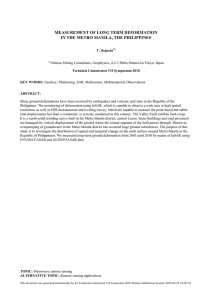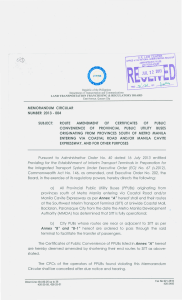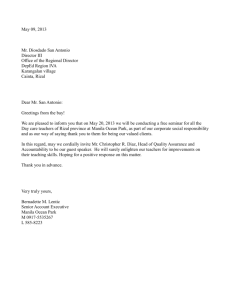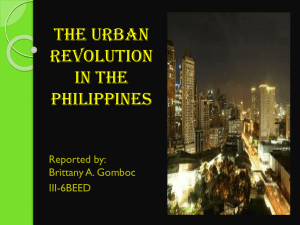Information Needs, Opportunities and Constraints - START
advertisement
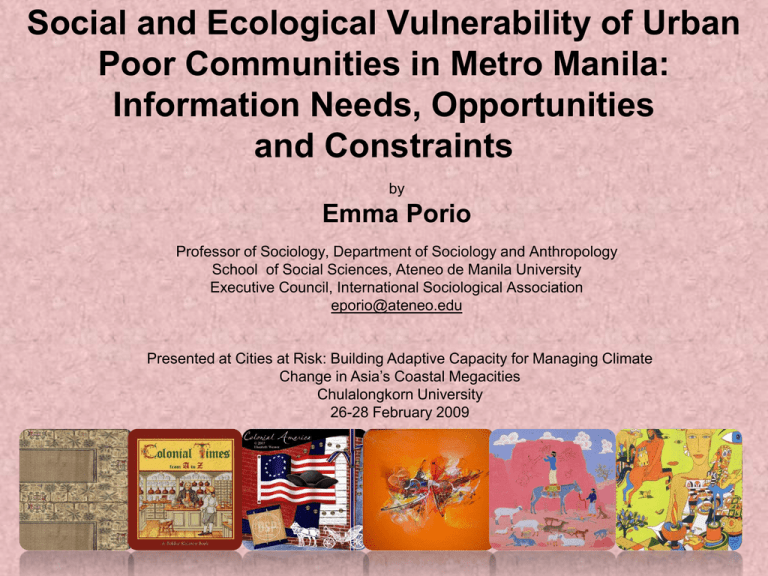
Social and Ecological Vulnerability of Urban Poor Communities in Metro Manila: Information Needs, Opportunities and Constraints by Emma Porio Professor of Sociology, Department of Sociology and Anthropology School of Social Sciences, Ateneo de Manila University Executive Council, International Sociological Association eporio@ateneo.edu Presented at Cities at Risk: Building Adaptive Capacity for Managing Climate Change in Asia’s Coastal Megacities Chulalongkorn University 26-28 February 2009 Urban Poverty in Metro Manila Poverty in Metro Manila Number of Informal Settlers in Metro Manila by City and Municipality, 2002 Poverty and Flood-prone areas in Metro Manila Poverty and Climate-related Risks in Metro Manila Slum community next to a major river in Pasay City. Slum community next to a railroad track in Manila City. Existing Data/Information Base: Response to the Needs of Vulnerable Population 1. Metro Manila:Heterogeneity,Specificity,Vulnerability Available data base, perceived needs, opportunities vary, one city to the other, within one city, barangay, vulnerable group: Ecological, social-political-economic vulnerability: e.g.,Taguig, migrant Muslim community vs. old-time residents GIS, Pag-Asa, Phivocs, National Disaster Coordinating Council, Civilian Defense System or Civilian Relations Service (CRS) Metropolitan Gov’t/Local Government Units: Decentralization and Information Bases The Most Vulnerable Populations in Metro Manila • Live in low-lying or swampy/wetlands, informal settlements • Low-income and/or no stable sources of income (less than US$ 1/day); high number of dependents • Majority (about 80 percent) have no security of tenure • About 75 percent have no adequate access to basic services (potable water, electricity, sanitation facilities get flooded, etc.) • About 75 percent regularly suffer income/job loss, sickness, and schooling of children as a result of floods/typhoons • About 75 percent suffer loss of HH appliances, garments or need house repair due to typhoons/floods • Single-headed/female-headed households (singles, widows, widowers and old) Existing Data/Information Base: Response to the Needs of Vulnerable Population Administrative Boundaries (LGU/MMDA) vs. Ecological Boundaries and Information Bases LGU:Marikina, disaster mitigation program vs. other cities in the Kamanava area, e.g., Navotas officials in collaboration with urban poor affected by sea level rise (SLR), storms, floods. a. Municipal data base system: List of barangays (or puroks/HHs) that are frequently flooded/evacuated during floods b. List of schools and other buildings as evacuation centers c. Barangay officials, teachers, tanods and their contact numbers in case of floods/typhoons and inventory of available resources d. A Barangay-Level Disaster Mitigation Task Force Constraints/Opportunities • Main issue: Access and Utilization of data (both formal data base system and insider knowledge system) for decision-making by the different stakeholders: - Analysis/Understanding vs. Policy, Programs for Disaster Mitigation, Adaptation, Resilience – – – • • Information data base/early warning devise system , e.g. water-gauge & siren/alarm system in Tumana, Marikina. Barangays: no early warning device—the monitoring of water levels or flood levels by those in situ and communicating these to the appropriate disaster response system/officials. Need to connect: Decision-makers (e.g., local/school officials) with information/resources to vulnerable populations who need/use it. Most decision-makers live in gated communities or areas that do not get flooded, so they cannot tell whether the residents in creeks and danger areas should be evacuated or not. Barangay and local/national officials with the task force handling disaster-related activities like evacuation, food distribution, and medical services Vulnerable Populations: Communicating information more efficiently/effectively to vulnerable populations in danger zones. Constraints/Opportunities • Adaptation/Resilience: Flood Water-Based Lifestyle and Information Systems – – – – Adaptation: Architecture/building/housing designs Water-based transport systems (Styrofoam boats and bancas at HH level; pedi-cab; bombastic or water diversion for LGUs) Household/Barangay organization adaptation for evacuation (plastic for wrapping garments, boots, raincoats, etc.) Drainage/sanitation adjustments • Maximizing and Linking Insider Knowledge of Vulnerable Populations (from lunar calendar and experience) and the Formal Knowledge (GIS, Information Warning Systems) • Updated and linked information system: HHbased/neighborhood based information linked to LGU information system (e.g. residential, commercial development that fill up/obstruct natural waterways, etc.) Linking ground-based information with those from ABOVE!!! • Information Needs:For Whom? For What? When? • Analysis/Understanding Policy, Planning, Implementation/Action • Variable/uneven data bases in different institutions, e.g. GIS mainly used by local gov’ts for tax mapping purposes • Access/utilization of vulnerability, hazard maps (e.g, suppress for fear of panic) • Disconnect between data base and potential users/non-users(MMDA,LGUs) Information Needs, Available Data: For Whom?What? Available, Accessible, Consumable by the appropriate stakeholder (researcher, planner, decision-makers at national/local level, etc.) Need to connect data bases from the ground or from above to the level of decision-making/action Threats to Sustainability: Climate Change and Disaster-Related Risks Threats to Sustainability: Climate Change and Disaster-Related Risks Maraming salamat po! Thank you!
